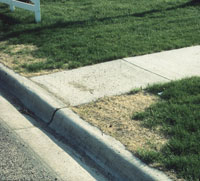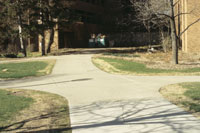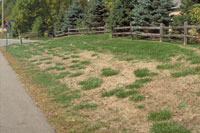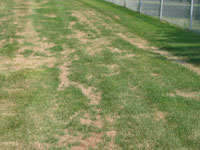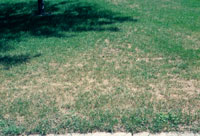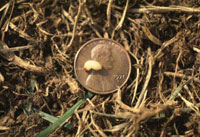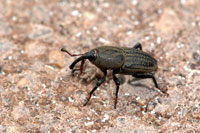Extension > Garden > Diagnose a problem > What's wrong with my plant? > Turf > Brown grass next to pavement or walkways
Turf > Brown grass next to pavement or walkways
1 of 4
De-icing salt injury
- Occurs following winter snow melt
- Long strips to irregularly shaped areas of dead grass often adjacent to paved driveways, sidewalks, street curbs, etc., where de-icing salts were applied
- Color or dead grass typically is light tan to straw-colored, later turning dark brown
- Usually a distinct boundary between affected and health plants
2 of 4
Damage related to ice cover
- Occurs where spring snow melt water cannot freely drain from an area due to blockage along edges of curbs, driveways, or sidewalks
- Occurs in open areas of the lawn where water goes through frequent freezing and thawing cycles during the snow melting process
- Long strips to irregularly shaped areas of dead grass
- Color of dead grass typically is light tan to straw-colored, later turning dark brown
- Usually a distinct boundary between affected and healthy plants
3 of 4
Heat and drought stress
- Occurs when temperatures are high (greater than 85° F) and little or no moisture is available through rain or irrigation for at least 2 to 3 weeks
- General browning of entire turf grass area; may also look thin and dry
- Affected areas may have clumps or tufts of green grass within areas of tan dry grass
- Occurs often in sunny, exposed lawn areas but can occur in dry, shady areas as well
- In most cases, cool season grasses will turn green and resume growth once cooler conditions and more frequent rainfall return
- If heat and drought stress have been severe for several weeks, affected lawn areas may not recover or may only partially recover
4 of 4
Bluegrass Billbug
- Damage most commonly seen during July and August
- Damaged areas yellow, then turning brown or straw-colored in small, irregular patches
- Particularly common near sidewalks, driveways, and other sources of heat
- 1/4 inch long, gray to black beetle with long, curved snout, active spring and late summer



